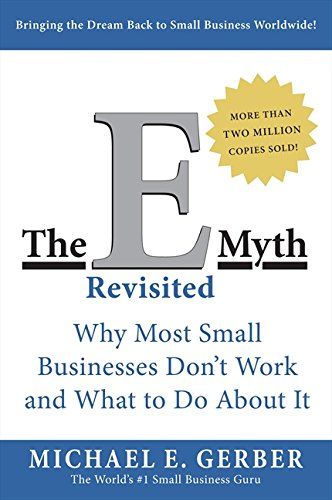
The E-Myth Revisited
Rating: 8.5/10
Author: Michael E. Gerber Read The OriginalHigh-Level Thoughts
This is a must-read for any business owner small or big. It centers around the myth of the entrepreneur. That small businesses are started by entrepreneurs risking capital to make a profit. Gerber gives business advice as he is telling a story of him giving business advice to a woman with a failing pie bakery. So many hidden gems and valuable lessons on how to prevent your business from becoming another statistic.
The E-Myth Revisited Summary
The E-Myth and the Small Business:
- The E-Myth -> The myth of the entrepreneur. That small businesses are started by entrepreneurs risking capital to make a profit.
- Fatal Assumption: if you understand the technical work of a business, you can understand a business that does technical work
- The problem is that when you go into business you're actually 3 people: The Entrepreneur, The Manager, and The Technician and they're all fighting for control.
- "I wonder" is the true work of the entrepreneurial personality.
- A business in infancy -> the owner and the business are one and the same thing.
- Businesses that can overwhelmed by fast growth who try to go 'small again' end up dying.
- "Simply put, your job is to prepare yourself and you business for growth. Educate yourself so you will become the foundation and structure that can carry additional weight"
- A mature company is founded on a broader perspective, and can work completely fine without the owner.
- "I realized that for IBM to become a great company it would have to act like a great company long before it ever became one" - [[Tom Watson]] #[[ 🖋 Quotes]] #Insight
Part II: The Turn-Key Revolution:
- Go to work on your business, not in it
- The Business Format Franchise not only lends its name to the smaller enterprise but it also provides the franchisese with an entire system of doing business.
- built on a. belief that its not what the business sells but how it sells it. Ray Kroc understood at Mcdonalds the hamburger wasn't the product, McDonald's was.
- The Franchise Prototype is the model of a business that works and satisfies your three personality types.
- The model will provide consistent value to your customers, employees, suppliers and lenders.
- The model will be operated by people with the lowest possible skill level.
- The model will stand out as a place of impeccable order.
- All work in the model will be documented in Operations Manuals.
- The model will provide a uniformly predictable service to the customer.
- The model will utilize a uniform color, dress and facilities code.
- Make the model system-dependent not people or expert-dependent.
- Consistency in the customers experience is extremely important
- The design of your logo, name and the package of the model all have significant impact.
Part III: Building A Small Business That Works
- Innovation -> getting new things done.
- Example -> changing how may I help you? to Hi, have you been here before? Sales increased by 10-16% by changing these few words.
- Quantification -> All innovations need to be quantified or they will go nowhere. (pretty much data analysis)
- Quantify everything.
- Orchestration -> Elimination of discretion, or choice -> keeping everything consistent, but at the same time unique.
- Your Business Development Program:
- Your Primary Aim -> the vision necessary to bring your business to life and your life to your business.
- Your Strategic Objective -> Clear statement of what your business has to do for you to achieve your primary aim.
- The commodity is the thing your customer actually walks out with in his hand
- Th eproduct is what your customer feels as he walks out of your business
- Your Organizational Strategy
- Have clear cut defined roles and descriptions of the responsibilities, no matter how small the business, this should include roles you will have 7 years from now.
- Begin documenting the most effective practices and how you are dealing with different situations.
- Your Management Strategy _. a system designed into your prototype to produce a marketing result.
- Your People Strategy -> Treat your employees seriously.
- "The work we do is a. reflection of who we are"
- There has to be an idea behind the work that was more important than the work itself.
- You don't need to hire professional managers
- Your Marketing Strategy
- The only thing that matters is what your customer wants. However many of these things are not clearly visible.
- 75% of buying decisions are made at the headline alone for print ads (which is why copyrighting is important)
- demographics -> who your customer is, and psychographics -> why he buys are two essential pillars to marketing.
- Your Systems Strategy
- Three types of systems: hard, soft and information.